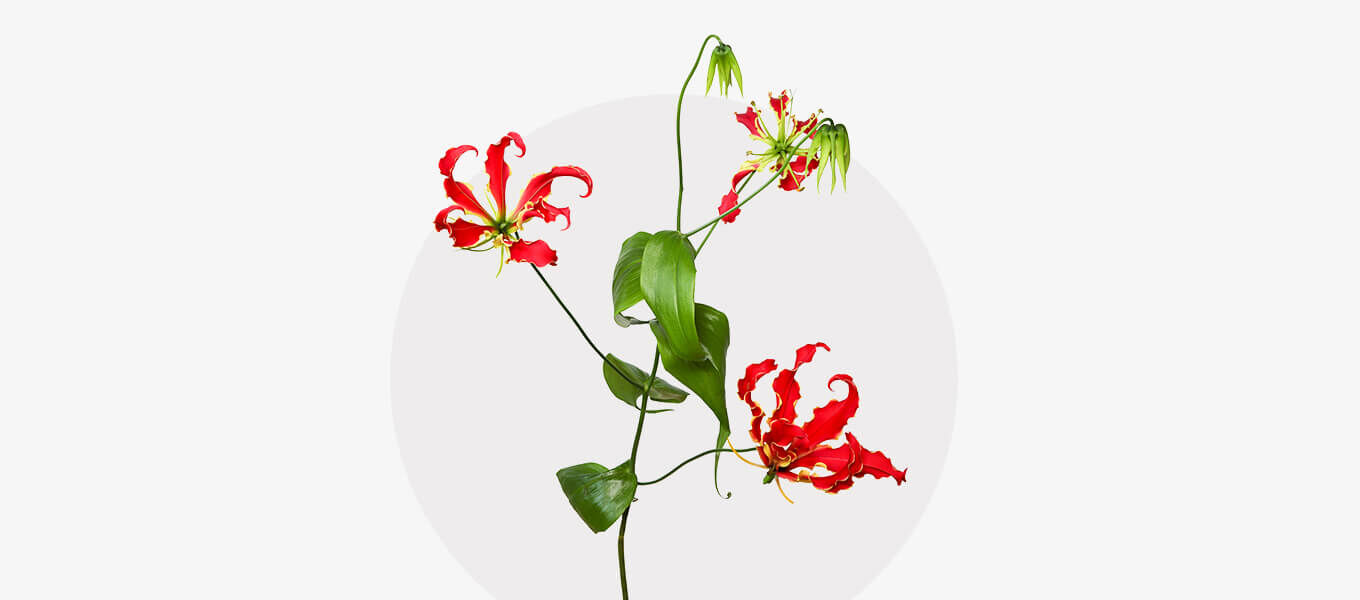Gloriosa lilies

The graceful crown of glory provides unusual colour accents in the jungle and at home. If you have a bit of flair and patience, you can also bring the Gloriosa into your living room - exotic tropical feeling included!
Flower
Its narrow, curved petals really do look like its name suggests: The crown of glory impresses with its fiery red flowers and a yellow throat - together the sight is reminiscent of a crown. Its botanical name Gloriosa makes it no less clear what a magnificent plant it is. As a species from the timeless family, it belongs to the lily family. It is the only species in this family that can climb. And its size is not enough, as its height is also majestic: Its shoots reach up to three metres. The six opening petals hang from 20-centimetre-long flower stalks. Depending on the species, the petals are curled or wavy. Its leaves are lanceolate in shape and have adhesive organs at their tips in the upper section - these help the gloriosa to hold on when climbing.
Exclusive jungle flair
As a true tropical plant, it is mainly native to Africa and Asia. It is found there in the form of impressive perennials whose flowers provide bright splashes of colour in the lush jungle green. Many well-known floral designers also use it as an eye-catcher - the gloriosa can be seen in numerous floristry competitions. Whether in an eccentric bouquet or an ikebana arrangement, the gloriosa has become an exclusive trend flower. The reigning world champion florist Alex Choi is also a fan of the graceful flower - in his home country of Korea, it may belong to the "forest and meadow plants", but this does not detract from its fascinating effect.
So if you want to bring a bit of jungle glamour into your living room, the Gloriosa is a good choice. One species in particular is of notable importance as a houseplant: the Gloriosa rothschildiana. However, Gloriosa superba, whose petal edges are more curled, is also occasionally found.
"The glorious one" for at home
The crown of glory is native to the rainforest in the shrub layer and likes to be as bright and sunny as possible here too. It needs a lot of light, so a place by the window is ideal. If you have the opportunity, you can also place it outdoors from May - but then in a warm place protected from the wind. In this country, it flowers in summer: at the earliest in June and into August. It can be found on the market either in pots or as tubers. When choosing a tuber, you should opt for the largest specimen, as this will ensure that you get the largest flowers. As the Gloriosa is very sensitive to waterlogging, it should not be kept too moist and the tuber should not be planted too wet. In general, it is a little hesitant at the beginning: if you are waiting for the first shoots, you should be patient. It takes quite a long time for the first sprout to appear - but then the gloriosa lives up to its glorious name: it now grows around ten centimetres a day.
Royal climber
To suggest a tropical climate, it is advisable to spray the leaves and shoots of the Gloriosa regularly on hot days. From a shoot length of 20 centimetres, you should also provide a climbing aid. The tendrils only need support to hold on to at the beginning, later the gloriosa will climb on its own. At the end of August, you should stop fertilising and gradually water less and less. In autumn, you can remove the wilted leaves and the bulb can spend the winter either in a pot or in a peat box at around ten degrees Celsius. You can then divide the bulb in spring - again, the bigger the bulb, the more glorious the flower. This way you can bring a real queen into your home with the crown of glory!













